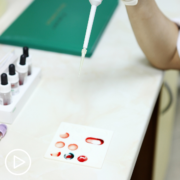What MPN Patient Type Is a Good Candidate for Telemedicine Visits?
What MPN Patient Type Is a Good Candidate for Telemedicine Visits? from Patient Empowerment Network on Vimeo.
What myeloproliferative neoplasm (MPN) patient type makes a good candidate for telemedicine visits? MPN expert Dr. Jamile Shammo shares her perspective of patient situations that work well for telemedicine and those who can benefit from in-person visits as part of ongoing care.
See More from MPN TelemEDucation
Related Resources:

Using Telemedicine to Help MPN Clinical Trial Enrollment After COVID-19 |

|
Transcript:
Lisa Hatfield:
As more institutions start to have in-person visits instead of only telemedicine visits, you might be wondering if you should keep doing telemedicine visits or move back to seeing your physician in-person. Some people might want to continue doing telemedicine for a number of reasons, including convenience/no travel involved and limiting your exposure to colds/infection from other patients. There are certain MPN patients that could be seen with telemedicine visits or fewer in-person visits. Listen as Dr. Jamile Shammo explains.
Dr. Jamile Shammo:
So, when I think of the patient that might benefit most from seeing the physician via televisit, for example, it would be someone who perhaps has a stable disease, someone who I may want to monitor perhaps every three to six months, someone who may have stable counts, and we’re just talking to about their symptoms and monitoring those types of things every so often. And perhaps I look at the labs, and you can discuss their symptoms and whether or not they have splenomegaly and issues like that.
Lisa Hatfield:
As Dr. Shammo notes, if your MPN is considered stable and you typically only see your doctor every three to six months, it might be worth continuing telemedicine visits instead of going back to in-person visits.
Dr. Jamile Shammo:
Someone who may already be on a stable dose of medication and we don’t have to do any dose adjustments and even if we have to do those adjustments, perhaps we could do labs a little more frequently, so that would be all right too.
Lisa Hatfield:
If you are on a stable dose of your medication and don’t need any modifications or just have minor adjustments, you could consider staying with telemedicine visits.
But what patients should consider doing more in-person visits, now that COVID-19 precautions are lighter? Dr. Shammo goes on to explain THAT patient could be…
Dr. Jamile Shammo:
Someone in whom I would like to initiate in treatment, someone in whom the disease may be progressing a little too quickly, someone who I may want to do an exam and assess their spleen, I suppose you could send them to an ultrasound facility and obtain an MRI or a CT, or an ultrasound of the imaging study that is. But there’s nothing like an actual exam of the patient. You are thinking about the disease progression, so those sorts of patients in which the disease is actually changing its pace, you may want to take a look at it, the full smear look and examine the skin for certain TKI and signs and symptoms of low platelets and that sort of thing. Look in the mouth for ulcers and things of that nature.
Lisa Hatfield:
As always, please discuss with your health care team before deciding to switch to only telemedicine visits or going back to in-person visits. They know your history and can help decide what is best for you and your care at this particular time.
Share Your Feedback:
Create your own user feedback survey


















